My interest in sword bayonets is largely academic. They are no longer issued by any army and any that you encounter will either be reproductions or date back to the 1940s if not earlier. That said, I thought I heard an odd noise in my flat the other night. Moving to investigate, the nearest weapon to hand was a M1917 sword bayonet. Even though a philistine of a previous owner had ground the edge off, it was still a handy thrusting weapon, its dull blade virtually invisible in the darkness. Ironically the noise proved to be nothing, and was probably the settling of some sword bayonets I had been examining as research for this series of blogs.
Very little has been written about the use of sword bayonets as hand weapons. The most well-known that springs to mind is Drexel-Biddle’s “Do or Die”. In this book, he relates an account of two marine aviators who took to wearing sword bayonets after training with Biddle. These two aviators were to later successfully defend themselves with these weapons against a mob of blade-armed foes.
Drexel-Biddle only describes a couple of techniques in his book. As some readers will know, Biddle was influenced by the school of thought that knife-fighting resembles sword-fighting. While this is open to dispute, it must be observed that 17" sword bayonets do have more in common with swords than most knives.
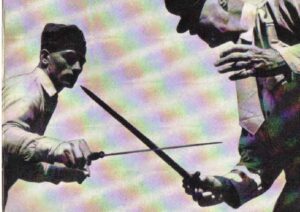

First photo shows an inward parry. Second photo shows the weak hand taking over the defence and grabbing the parried arm. The same technique can be applied as an outward parry. The unarmed hand takes over control of the foe’s knife hand and at the same time the bayonet counter-attacks. With an outward parry, one would probably thrust over the top of the arm towards the throat or face. Alternately, one could follow the wrist grab with a cut downwards at the attacker’s knife hand.
The next sequence shows a number of counter attacks. As the names may suggest, these are inspired by renaissance sword fighting techniques.

The Inquartata involves stepping back with your left foot to follow a quarter circle or further. This swings the body out of the path of an attack and positions your right side to deliver a counter thrust. Drexel-Biddle is aiming at the chest but the throat or face may be more prudent.

The Stoccata also involves the left foot, but this time you use it to step to your left, or forward to your left, to evade the attack. Biddle is thrusting under the attacker’s arm. Ideally drive this attack into the armpit where the artery is. A deep hit will also affect the shoulder joint.

The Passata Soto is a step to the left combined with a duck under the attack. Ideally, use the Capoeira footwork I describe in my book to move past the attacker’s right side when executing this counter attack.
These techniques can, of course, be used if you do not have a sword bayonet. A friend of mine was asking me about knife crime and I pointed out to him a rolled up magazine can be a very useful defensive tool in such a situation. View the photos and text above again and imagine executing them with a rolled up magazine. A strike to the throat or under the arm may not be as deadly as a bayonet, but can still be very effective.
For information on how to build on the above defensive techniques, please buy my book.
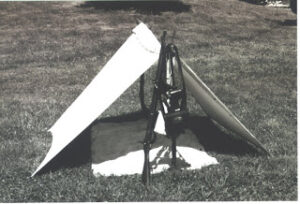
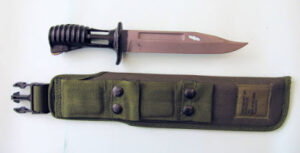

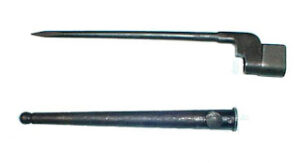
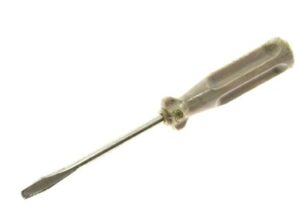






 derived from a civilian tool favoured by outdoorsmen. Hangers, “short hunting swords” or “couteau de chasse” were useful for chopping firewood, clearing brush and butchering game. They were carried by noble and commoner alike. There are exciting accounts of them being used to hunt game and they were a useful defence against both beast and man. Decorated versions might be worn out court to display one’s affection for hunting. They might also be worn in town as a handy defence against robbers, in many cases being more effective and convenient than rapiers or small swords. Understandably the common foot soldier found the hanger to be a useful implement. In addition to the sword bayonet the hanger is probably the ancestor of both the naval cutlass and the machete, and is why you occasionally come across machetes referred to as cutlasses. Sword bayonets were created to produce a bayonet that also served as an infantryman’s hanger. The yataghan configuration blade provided better clearance for the hand when reloading a muzzle-loading weapon. The blade shape is not without other merits so a number of breech loaders also used sabre bayonets.
derived from a civilian tool favoured by outdoorsmen. Hangers, “short hunting swords” or “couteau de chasse” were useful for chopping firewood, clearing brush and butchering game. They were carried by noble and commoner alike. There are exciting accounts of them being used to hunt game and they were a useful defence against both beast and man. Decorated versions might be worn out court to display one’s affection for hunting. They might also be worn in town as a handy defence against robbers, in many cases being more effective and convenient than rapiers or small swords. Understandably the common foot soldier found the hanger to be a useful implement. In addition to the sword bayonet the hanger is probably the ancestor of both the naval cutlass and the machete, and is why you occasionally come across machetes referred to as cutlasses. Sword bayonets were created to produce a bayonet that also served as an infantryman’s hanger. The yataghan configuration blade provided better clearance for the hand when reloading a muzzle-loading weapon. The blade shape is not without other merits so a number of breech loaders also used sabre bayonets.

